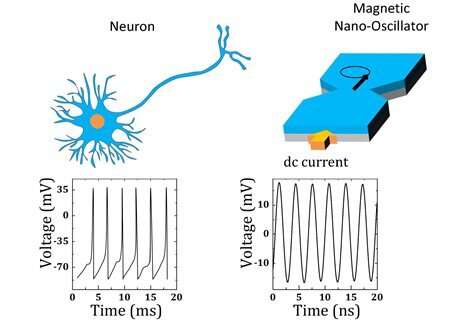Quantum materials-based magnetic nano-oscillators provide functionality similar to that of neurons operating via periodic peaks. Credit: The Grainger College of Engineering, University of Illinois Urbana-Champaign
In its heyday, UIUC’s Blue Waters was one of the world’s best supercomputers. Anyone curious could stop by the 30,000-square-foot engine room for a tour and spend half an hour strolling among the 288 huge black cabinets, backed by a 24 megawatt power supply, which housed its hundreds of thousands of computing cores.
Blue Waters is gone, but today UIUC is home to not just one, but tens of thousands of vastly superior computers. Though these wondrous machines put Blue Waters to shame, each weighs just three pounds, can be fed coffee and sandwiches, and is only the size of its owner’s two hands curled together. We all wear them between our ears.
The fact is that humanity is far from having artificial computers that can match the capabilities of the human brain, beyond a limited number of well-defined tasks. Will we ever capture the magic of the brain? To help answer that question, MRL’s Axel Hoffmann recently led the writing of a APL materials “Perspectives” article summarizing and reflecting on efforts to find so-called “quantum materials” that can mimic brain function.
“The basic idea of what we’re discussing in this article is this: that information technologies are becoming more energy-intensive,” said Hoffmann, founder and professor of Materials Science & Engineering. “You know, we’re using a lot more computing power than we used to for all sorts of things…and some of these things take a surprising amount of energy.”
In addition, traditional Complementary Metal Oxide Semiconductor (CMOS) computers are not even suitable for many of today’s computing tasks, such as image recognition, where data with noisy and ill-defined features can matter. “CMOS is designed to be a really high-precision machine, keeping different states of information well separated,” explains Hoffmann. “So it’s not very well designed to do things with a lot of randomness and fluctuation.”
The human brain, on the other hand, can easily handle such difficult tasks, while consuming significantly less energy than modern computers. “So the idea now is: can we take inspiration from the natural brain to find more energy-efficient ways to process information?” asks Hofmann.
According to the line of research discussed in the article, the solution will be “materials that have some of the same properties you find in the natural brain.”
Certain “quantum materials” — materials whose physical properties cannot be fully described in simple terms — seem to fit the bill. For example, some of them tend to oscillate in a way similar to the oscillations that naturally form in the brain.
“We want to look at materials that are inherently unstable and fluctuating,” Hoffmann says. “It’s very different from the traditional computer, where you want very large energy barriers between your logical zeros and ones so that they are well defined and well separated.”
Furthermore, in a traditional computer, memory and computing unit are separated and data is constantly shuffled back and forth – a major reason why the computation is so energy-intensive.
“In the natural brain,” on the other hand, “computation and memory are much more co-located,” Hoffmann says. “Information…is much more spread out across the network, so there’s no need to move it.”
Quantum materials, in short, open the door to computers that offer highly energy-efficient “back and forth” and can juggle multiple possible states while consuming very little energy.
Hoffmann co-authored the Perspectives piece with his colleagues at the UCSD-led, DOE-funded Quantum Materials for Energy Efficient Neuromorphic Computing center. His own research in this area focuses mainly on magnetic materials and how magnetic oscillating systems can be scaled up from proof-of-concept experiments to usable systems.
Quantum computer works with more than zero and one
Axel Hoffmann et al, Quantum materials for energy-efficient neuromorphic computing: opportunities and challenges, APL materials (2022). DOI: 10.1063/5.0094205
Quote: Researcher studies materials whose properties resemble those of the human brain (2022, Aug. 3), retrieved Aug. 3, 2022 from https://phys.org/news/2022-08-materials-traits-resemble-human-brain .html
This document is copyrighted. Other than fair dealing for personal study or research, nothing may be reproduced without written permission. The content is provided for informational purposes only.

